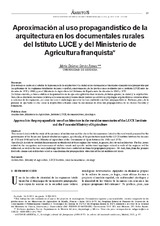Mostrar el registro sencillo del ítem
Aproximación al uso propagandístico de la arquitectura en los documentales rurales del Istituto LUCE y del Ministerio de Agricultura franquista
| dc.contributor.author | García Ramos, Mª Dolores | |
| dc.date.accessioned | 2023-03-20T12:32:34Z | |
| dc.date.available | 2023-03-20T12:32:34Z | |
| dc.date.issued | 2022 | |
| dc.identifier.issn | 1575-2100 | |
| dc.identifier.issn | 2386-4494 | |
| dc.identifier.uri | http://hdl.handle.net/10396/25015 | |
| dc.description.abstract | Este trabajo se centra en el estudio de la presencia de la arquitectura y la ciudad en los documentales vinculados al mundo rural promovidos por los gobiernos de los regímenes totalitarios italiano y español, concretamente, de las producciones realizadas por el instituto LUCE entre las décadas de 1920 y 1940 y por el Ministerio de Agricultura del Gobierno de España entre las décadas de 1940 y 1970. De forma concreta, se busca establecer los parámetros en los que estos gobiernos han valorado, de forma general, la ciudad y la arquitectura. Para ello se abordarán cuestiones relativas al reconocimiento y valoración de tendencias estilísticas y tipologías arquitectónicas concretas afines a cada uno de los regímenes, así como los usos y simbología que estos les han conferido con fines propagandísticos. Partimos, pues, de la premisa de que tanto el cine como la arquitectura actuaron como un mecanismo de atracción propagandística de los ideales fascistas y franquistas. | es_ES |
| dc.description.abstract | This research deals with the study of the presence of architecture and the city in the documentaries linked to the rural world promoted by the governments of the Italian and Spanish totalitarian regimes, specifically, of the productions made by the LUCE institute between the decades of 1920 and 1940 and by the Ministry of Agriculture of the Government of Spain between the 1940s and 1970s. Specifically, it seeks to establish the parameters in which each of these regimes has valued, in general, the city and architecture. For this, issues related to the recognition and assessment of stylistic trends and specific architectural typologies related to each of the regimes will be addressed, as well as the uses and symbology that these have conferred on them for propaganda purposes. We start, then, from the premise that both cinema and architecture acted as a mechanism for propagandistic attraction of fascist and francoist ideals. | es_ES |
| dc.format.mimetype | application/pdf | es_ES |
| dc.language.iso | spa | es_ES |
| dc.publisher | Asociación de Estudios de Ciencias Sociales y Humanidades | es_ES |
| dc.rights | https://creativecommons.org/licenses/by-nc-nd/4.0/ | es_ES |
| dc.source | Ámbitos 48, 39-52 (2022) | es_ES |
| dc.subject | Arquitectura | es_ES |
| dc.subject | España. Ministerio de Agricultura | es_ES |
| dc.subject | Instituto LUCE | es_ES |
| dc.subject | Documental rural | es_ES |
| dc.subject | Ideología | es_ES |
| dc.subject | Architecture | es_ES |
| dc.subject | Spain. Ministry of Agriculture | es_ES |
| dc.subject | LUCE Institute | es_ES |
| dc.subject | Rural documentaries | es_ES |
| dc.subject | Ideology | es_ES |
| dc.title | Aproximación al uso propagandístico de la arquitectura en los documentales rurales del Istituto LUCE y del Ministerio de Agricultura franquista | es_ES |
| dc.title.alternative | Approach to the propagandistic use of architecture in the rural documentaries of the LUCE Institute and the Francoist Ministry of Agriculture | es_ES |
| dc.type | info:eu-repo/semantics/article | es_ES |
| dc.relation.projectID | Gobierno de España. PID2019-105462GB-I00 | es_ES |
| dc.rights.accessRights | info:eu-repo/semantics/openAccess | es_ES |

